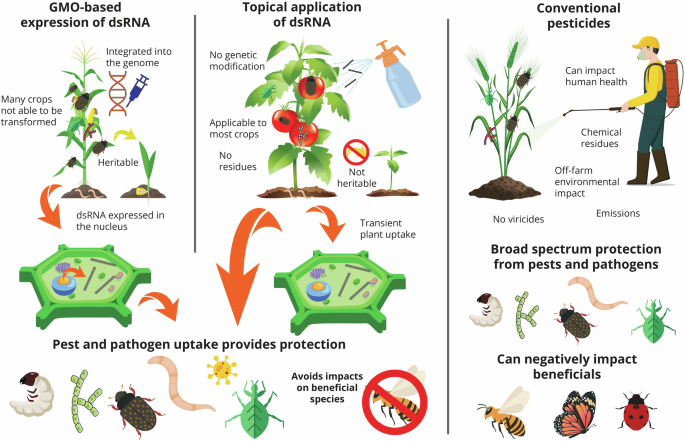Revolutionary RNAi Tech for Eco-Friendly Pest Control
Imagine a future where battling agricultural pests doesn’t involve broad-spectrum chemicals that harm beneficial insects and the environment. This future is rapidly becoming a reality, thanks to groundbreaking advancements in precision targeted RNA interference biopesticide technology. This innovative approach offers a powerful new weapon for pest biocontrol, promising a more sustainable and effective way to protect our crops and ecosystems.
The Power of Precision: How RNAi Works
At its core, RNA interference (RNAi) is a natural biological process found in most living organisms. It’s a cellular mechanism that silences genes, effectively turning them off. Scientists have harnessed this natural ability to create highly specific biopesticides.
Unlocking Nature’s Silencing Mechanism
Think of it like a highly specific lock and key. RNAi pesticides are designed as tiny RNA molecules that are complementary to a specific gene essential for the target pest’s survival. When these RNA molecules are ingested or absorbed by the pest, they bind to the corresponding messenger RNA (mRNA) within the pest’s cells.
Targeted Gene Silencing
This binding prevents the pest’s cells from producing the vital protein encoded by that gene. Without this essential protein, the pest cannot grow, reproduce, or survive. The beauty lies in its specificity; the RNAi molecule is designed to target only the pest’s gene, leaving beneficial insects and other organisms completely unharmed.
Why RNAi Biopesticides Are a Game-Changer
The implications of this precision technology are vast. Traditional pesticides often have a wide range of effects, leading to unintended consequences. RNAi biopesticides offer a starkly different, and often superior, alternative.
Unmatched Specificity and Safety
One of the most significant advantages is the extreme specificity. This means that an RNAi biopesticide designed to combat a particular type of aphid, for example, will only affect that aphid species. It won’t harm ladybugs, bees, birds, or other non-target organisms. This dramatically reduces the ecological footprint of pest management.
Reduced Environmental Impact
The targeted nature also means less chemical residue in our food and environment. This is crucial for consumers, farmers, and environmental health advocates alike. It aligns perfectly with the growing demand for sustainable agricultural practices and organic farming.
Combating Resistance
Pests are notorious for developing resistance to conventional pesticides over time. RNAi offers a novel mode of action that can help overcome existing resistance issues and is less likely to lead to the rapid development of new resistance compared to older chemical agents. This ensures long-term efficacy.
Versatility Across Pests
While early applications have focused on insect pests, the underlying RNAi technology is adaptable. Researchers are exploring its potential for controlling other types of pests, including nematodes and even some fungal pathogens, opening up a broad spectrum of biocontrol possibilities.
The Science Behind the Innovation
Developing these precision biopesticides is a complex scientific endeavor. It requires a deep understanding of pest genomics and molecular biology.
Identifying Target Genes
The first crucial step involves identifying genes that are essential for a pest’s survival and are unique to that pest species. This often involves extensive genomic sequencing and bioinformatics analysis.
Designing and Synthesizing RNA Molecules
Once a target gene is identified, scientists design short RNA molecules (often called double-stranded RNA or dsRNA) that will trigger the RNAi pathway in the pest. These molecules are then synthesized in a laboratory.
Delivery Methods
Getting the dsRNA to the target pest is another critical aspect. Common methods include:
- Spraying the dsRNA directly onto crops.
- Incorporating the dsRNA into baits or lures.
- Engineering plants to produce their own dsRNA.
The dsRNA is formulated to be stable and effective when applied in the field. When the pest consumes or absorbs the treated material, the RNAi process is initiated within its body.
Applications and Future Potential
The impact of this technology is already being felt across various sectors of agriculture and beyond.
Protecting Key Crops
RNAi biopesticides are being developed and deployed to protect high-value crops from devastating insect pests. This includes fruits, vegetables, and row crops that are vital for global food security.
Sustainable Agriculture
For farmers seeking to adopt more sustainable practices, RNAi offers a powerful tool to reduce their reliance on chemical pesticides. This can lead to healthier soil, improved biodiversity, and safer working conditions.
Integrated Pest Management (IPM)
RNAi biopesticides are an excellent fit for Integrated Pest Management programs. They can be used in conjunction with other control methods, such as biological control agents and cultural practices, to create a robust and resilient pest management strategy.
Expanding Horizons
The potential applications are vast and continue to expand. Researchers are actively investigating ways to use RNAi to control:
- Invasive insect species that threaten native ecosystems.
- Pests that transmit diseases to humans or livestock.
- Arthropods that damage stored food products.
- Parasitic organisms in veterinary applications.
For a deeper dive into the science of gene silencing and its applications, the National Institutes of Health (NIH) offers extensive resources on RNA interference: NIH RNA Interference Resources.
Challenges and the Road Ahead
Despite its immense promise, challenges remain. Ensuring the stability and efficacy of dsRNA in diverse environmental conditions is an ongoing area of research. Cost-effective production and regulatory approval processes are also critical factors for widespread adoption.
However, the trajectory is clear. As research progresses and manufacturing capabilities improve, RNAi biopesticides are poised to become a cornerstone of future pest management strategies. This technology represents a significant leap forward in our ability to protect our food supply and environment in a responsible and sustainable manner.
The development of precision targeted RNA interference biopesticide technology is not just an advancement; it’s a revolution in pest biocontrol. By leveraging nature’s own genetic silencing mechanisms, we are opening the door to a future of agriculture that is both highly productive and remarkably gentle on our planet.
Ready to embrace the future of pest control? Explore how these innovative biopesticides can transform your approach to protecting crops and the environment. Learn more about the science and its applications today!









